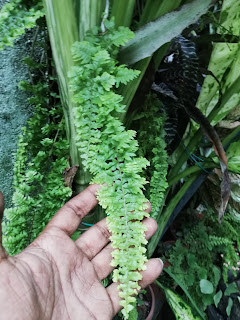My first experience with this particular one was a failure. I had over-watered it and killed it due to root-rot. I was wondering, how come I had managed to kill one of the most hardy type of ferns - the Bird Nest Fern (Asplenium Nidus)
Bird Nest Fern can grow fairly large given the space for the rootball to grow.
Often I had found these big ones are thrown & cast aside when it had overgrown and the rootball had grown too big and the leaves are extremely huge, often get damaged and burned due to it's size and nature.
Currently, new varieties had been introduced in the market where it has wavy features on the foliage but these are considered sensitive compared to the normal version. Due care is required on the humidity and over watering as these can rot easily.
These my experience with them (10 years ago) when I grow it in a big hanger pot which eventually broke due to the heavy weight of the rootball. I had given this plant away to a friend.
These my experience with them (10 years ago) when I grow it in a big hanger pot which eventually broke due to the heavy weight of the rootball. I had given this plant away to a friend.
Also, I found Episcia (Flame Violets) loves to grow together inside the fern root-ball.
The downside of the keeping the Bird Nest Fern in a huge size is that the mature leaves tend to burn and look unruly. Unless you have a big garden space, it will grow huge and well but it is not practical for small space garden.
I had recently purchase this particular variegated bird nest fern.
I really love this one especially seeing white colored stripes on them.
Like most ferns, the Care & Cultivation is almost similar to most fern Allies.
WATERING
The love high humidity, not too wet & not too dry - the medium in the root ball must be moist wet. Do allow it to dry before watering but check on the condition of your garden.
If your garden is too dry then water more, if your garden gets wet often, the refrain from over-watering it.
This is a hardy fern, so it is not so difficult to care for it compared to the rest of the fern allies.
UNDER WATERED - FOLIAGE FEATURE:
You will notice that the leaf may look burned, withered and limp - almost like paper crisp if it is lacking water. The colors looks lighter than bright brilliant green.
OVER-WATER
The leaf will show signs of yellowing all over the plant, sometimes with burned edges. Sometimes the whole leaves will fall off if the root-ball is sitting inside the water and the whole thing is rotting.
- Do remove everything and let it dry off a day or wrap the whole root-ball with paper towel as the water is soaked off to the paper towel. Too much soaking root medium can kill this fern.
LIGHT
All ferns prefer indirect bright light.
It can also do well in full shade but it may take few adjustment around the garden to check and balance to see where it does well. Normally it may require on hanging pot in shaded areas but it does well to on pots placed on ground.
FEEDING
These ferns do very well using organic fertilizers like chicken manure, rice washed water and banana peel. I found that common conventional granule types burns these ferns and will not recommend it - perhaps try it out first in a one single pot with low dosage and observe it.
Also used tea-bags with tea inside it - using it as additional organic fertilizer makes this fern grows well.
Overall, Bird Nest Fern is an easy plant to cultivate and I would recommend it for new beginners who would love to venture into this kind of ferns.




































































